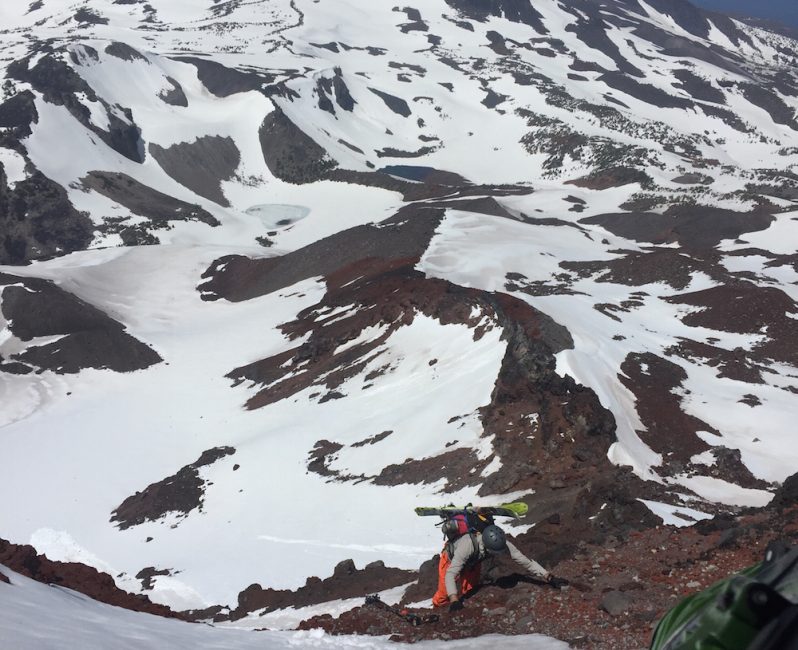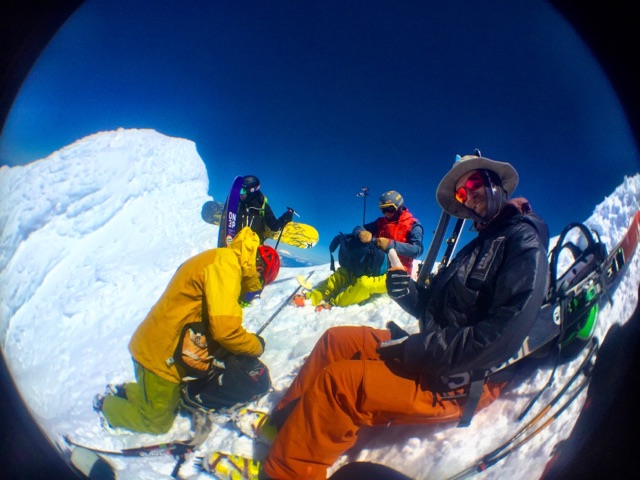Editor’s Note: Skier, entrepreneur and dedicated Dad Sherpa Ben McKinley has been getting into all sorts of adventures of late. His latest and most ambitious involves three ski summits in one day, in beautiful Central Oregon. He shares lessons learned and an excellent video documenting an intense journey.
The Three Sisters are icons of my love affair with Central Oregon, a prominent cluster of volcanic peaks in the skyline visible from almost any vantage point in the region. Combined with Mt. Bachelor and Broken Top, they form a rare collection of peaks in a range that is otherwise known for the large distances between the prominent peaks. I’ve toyed with the idea of linking up all three on skis for the last 10 years, especially after hearing of Chris Davenport’s team accomplishing that feat as part of their Ring of Fire Tour in 2012.
Since then, I have been working to collect as much beta from the few people who know the route well, in order to make an attempt of the traverse myself. It all came together on June 1, 2016 with my first climbing buddy and long time friend, David Marchi. David owns Crow’s Feet Commons in Bend and has a high tolerance for pain to compliment his deep mountain and ski guiding background.
As with any adventure at this stage of my life it was two adventures in one. The first was finding time to squeeze the traverse into my packed schedule. The second was the adventure itself.
I have the constant pleasure and pressure of running my web company, cascade web development. On top of that, my oldest daughter’s birthday is on June 2nd. She had her birthday party on May 31st, which was the Monday of Memorial Day weekend. Following her party, I loaded up and headed for Bend. The mountains were calling and conditions were right. We had been weathered out the week before so forcing in the June 1 date allowed me be back for my daughter’s birthday and keep the rest of life moving along.
Given the lack of information on a tour of all three of the Sisters peaks, I wanted to share some beta that I hope others find valuable in considering and possibly planning for such a mission. So here goes:
Time of Year: I suggest doing the traverse in the late spring once the road from Dutchman Flat to Elk Lake is open. This eliminates about 8 miles of touring on the road at the end of the tour. That is unless you’re able to line up a tow out on a snow machine earlier in the season. The road usually opens around Memorial Day weekend. This year it opened on Monday, May 23. You don’t want to wait too long after the road opens as snowmelt happens fast and you can spend a lot of time hiking if its a bad snow year and/or a hot spring.
Traverse Direction: Most people ski the traverse north to south from Pole Creek to Devils Lake. Reason being that you ascend the sun protected, firmer north facing peaks and descend the south facing corn loaded slopes.
Fast and light: There is always a balance between safety and weight. Especially when trying to cover 20 miles and 10,000’ of elevation gain. Given the stable conditions, we opted to leave the shovel, probe and beacon at home. We packed crampons and ice axes and whippet. We did not bring any rope or protection, either. Some items we did bring included helmets, a JetBoil stove, robust first aid kit and emergency sled. Find that balance that works for you.
Start Early: We set our alarm for 2:30 am and were on the trail by 5 am. We hoped to complete the route in 12 hrs. It ended up taking us 12.5 hrs.
Shuttle: We arranged for a morning shuttle by our friend Jonas. What a trooper! That was huge in that we certainly didn’t want to spend a couple hours in the car at the end of the mission retrieving a vehicle at Pole Creek. We discussed leaving a vehicle at Devil’s Lake, but opted to hitch a ride back to Bend. That worked out thanks to the lovely ladies headed back from their mellow day at the lake.
North Sister Route: North Sister is known as the most technical of the three. Following advice of Jonas and others, we elected to head up the Hayden Glacier between Middle and North Sister and veer north up the south face of North Sister. This is the safest approach by far. We attained the summit ridge and opted not to tag the summit proper via some technical and exposed terrain. This saves precious time and allowed us to leave the protective gear in the vehicle. You then ski back the way you came up as you head toward Middle Sister. At this point, you’ve climbed roughly half the vertical distance of the day. Took us about 5.5 hours to get this far.
North to Middle Sister: This portion is rather straightforward. The north face of Middle Sister was a bit steep, but easily bootpacked. The distance between peaks and elevation loss/gain is small compared to the gap between Middle and South Sisters. Took us less than 2 hrs to get from one summit to the other. At this point, you’re about half way there, distance wise and 2/3 the vertical gain.
Middle to South Sister: South Sister is a long way from Middle Sister. It’s a bit daunting, frankly, how far you have to travel. You descend about 3,000’ down the south face to Chambers Lakes. Trend left on the south summit ridge. We went too far right/west and missed some vertical that would have been prime. Next time. Work your way South along the saddle to Chambers Lake. This was a fairly long traverse with relatively easy route finding.
South Sister was the CRUX: While South Sister is generally considered the easiest of the three, this is not the case when talking about the traverse. The north face has some real exposure and challenging sections. We headed up the prominent ridge you see from town. The final 1,000’ is on a left sloping face that cliffs out with gaping bergschrunds below. There is a 10-foot crumbling rock step at the base of the final face that was the true crux of the day. Some protection here would have been comforting. We had neither protection nor comfort. Not only are you pretty spent, you are also a long way from help. Be methodical here. Don’t underestimate it. There had been fresh snow the week before, for friendly bootpacking on the final face. The pitch would have been more terrifying if the snow was firm. Then again we used neither crampons nor ice axe on the pitch. They would dramatically reduce pucker factor, especially on firm snow.
Alternate Route: Turns out there is a far mellower ridge further to the right/west of the one we selected. It requires wrapping further around the west side of the South Sister which results in more distance but far less exposure. I would recommend this route to any first timers. I’ll use it next time. Also, I’ve heard the South to North direction is a favorite for dry season traverses (hikers and runners). This further west route would be far less treacherous for them as well.
South Sister Summit and Descent: The true summit of South Sister is left/east of where you top out. Tag that and then follow the well trodden trail south off the summit. The route out is pretty straightforward. In general, trend left after the long flat section below the main ski pitch. Otherwise you end up down in Moraine Lake and have to climb back out. Work your way through the trees till you run out of snow. From there, boot it out until you hit the road.
Partner Selection: While it’s always important to choose a strong partner, it’s even more so the case on a mission like this. Once you’re committed, there is no easy retreat back to the car. It’s critical you make sound decisions and are ready to deal with a bad situation, should it arise. Fitness is important with the distance and vertical gain of this trip. Be realistic and make sure all team members are prepared and capable.
This trip represented the single largest ski mountaineering effort I’d ever experienced in the mountains in terms of distance and vertical rise. Things worked out extremely well for one of those cherished memories I’ll never forget. Hopefully this helps clarify some of the details that went into planning and executing the day. It was no small feat!
 Ben McKinley (pictured with his daughter Lauren) is a hardcore Dad Sherpa, CEO of Cascade Web Development in Portland and freeride coach with Multnomah Athletic Club.
Ben McKinley (pictured with his daughter Lauren) is a hardcore Dad Sherpa, CEO of Cascade Web Development in Portland and freeride coach with Multnomah Athletic Club.
Last modified: July 8, 2016




